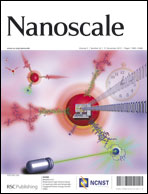Bi-directional-bi-dimensionality alignment of self-supporting Mn3O4 nanorod and nanotube arrays with different bacteriostasis and magnetism†
Abstract
Self-supported Mn3O4 patterns of aligned nanorods and nanotubes were synthesized through a bi-directional-bi-dimensionality growth model by using sodium gluconate and urea as additives under mild hydrothermal conditions without the use of any substrates. In one direction, Mn3O4 grows to form one-dimensional nanorods or nanotubes, while in the other direction Mn3O4 grows into two-dimensional nanoplates to support the nanorods or nanotubes to align into arrays. These two kinds of new nanostructures, a nanotube pattern and a nanorod pattern, show similar and good bacteriostasis for Gram positive bacteria, but for Gram negative bacteria the nanotube pattern shows much better bacterial restraint than the nanorod pattern. Magnetic studies show that the nanorod arrays display similar magnetic properties to the commercial Mn3O4, while the nanotube arrays show different ferromagnetic behaviors with enhanced remnant magnetization and saturation magnetization (Ms) at low temperature.


 Please wait while we load your content...
Please wait while we load your content...